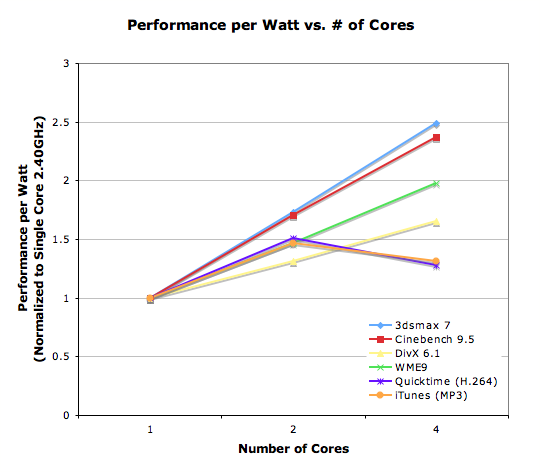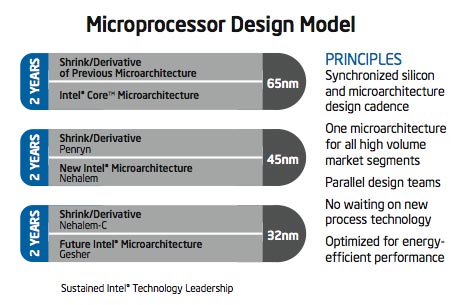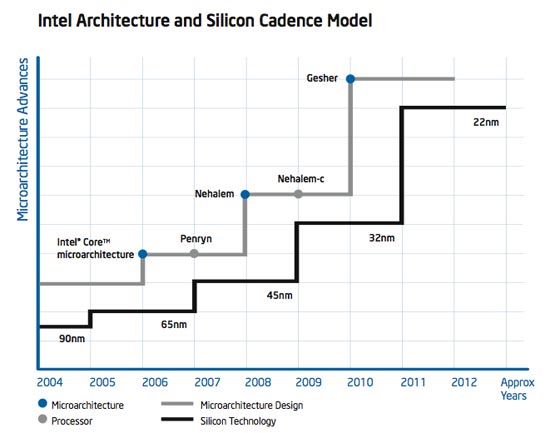Intel's Core 2 Extreme QX6700: The Multi-core Era Begins
by Anand Lal Shimpi on November 2, 2006 2:14 AM EST- Posted in
- CPUs
Analyzing Efficiency Trends
The graph below summarizes the data pretty well; what you're looking at is a graph of normalized performance per watt in six applications as a function of the number of cores in a Core micro-architecture CPU:

The graph illustrates exactly what we've confirmed here today: having more cores does increase efficiency if the software is designed to take advantage of those additional cores.
We have not yet hit the point of diminishing returns with adding more cores, but the two downward trending curves show the current problem with scaling from two to four cores. Very few desktop applications can take good advantage of a dual core CPU and even fewer are geared for quad core chips, and in those applications these quad core processors are actually a step back in terms of efficiency; it's not a fault of the processor, but rather of the software.
Through the benchmarks on the previous page we also highlighted another important point to take away: even in the areas where performance and efficiency were both improved, they came at a very expensive cost: twice the transistor count of Core 2 Duo. As much as Intel may call the next decade the era of multi-core and thread level parallelism, we simply can't lose focus on improving instruction level parallelism and core level efficiency.

Thankfully Intel has recently announced that it will be updating its micro-architecture every two years in an attempt to avoid problems like what happened with NetBurst and the Pentium 4. If it weren't for this change in microprocessor design model, the quest for more cores would end up no differently than the gigahertz race.

If all goes according to plan, it looks like we will get one of those improvements to ILP and core efficiency by the end of 2007/beginning of 2008 with Nehalem in order to avoid hitting another efficiency brick wall.










59 Comments
View All Comments
JarredWalton - Thursday, November 2, 2006 - link
I am quite sure that 4x4 is for 1207 and not AM2. Sorry. I am also quite sure that 1207 will get quad core support, so long-term a 4x4 (dual dual core) can become... 4x8? (dual quad core). Anyway, in that sense it's just like Core 2 Duo and Quad.The questions I don't have answers to: will the 4x4 begin with a K8L chip, or just a tweaked K8? Will K8L be more competitive with Core 2? When will it finally come out? How much will it cost? Actually, I can sort of guess on the last point that 4x4 will cost a lot more than a Core 2 Quad config as you will need a more expensive mobo, RAM, and two CPU packages.
I *think* Anand plans to have an article delving into 4x4 and AMD's plans more in the future. Maybe he's still gathering data from AMD? (Sort of like squeezing water from a dry spongue at times, unfortunately....)
johnsonx - Thursday, November 2, 2006 - link
I don't think you're right on that one; 4x4 CPU's will use the same RAM as AM2 CPU's do. The "more expensive RAM" requirement is only for Opterons, which of course use registered ECC memory. In fact, if your chosen mainboard has memory banks for both CPU's, then you could even save a little since 4 smaller DIMMs tends to cost a little less right now than 2 bigger DIMMs.
JarredWalton - Thursday, November 2, 2006 - link
Except that like socket 940 vs. 939, I expect all 1207 boards to require registered DIMMs. I don't know of any dual socket board that doesn't.Griswold - Thursday, November 2, 2006 - link
The whole "catch" of 4x4 was that there are no ECC/Registered DIMMS required - at least that was the synopsis all the time. It should have very little to do with the socket itself, rather a matter of IMC, no?Anand Lal Shimpi - Thursday, November 2, 2006 - link
You're correct, 4x4 will use Socket-1207 CPUs but without Registered memory.Take care,
Anand
JarredWalton - Thursday, November 2, 2006 - link
I stand corrected, though I have to say I'm still not at all interested in getting a dual socket motherboard. LOL I guess 1207 CPUs will have to support both registered and unbuffered DIMMs? I can't imagine AMD trying to get people to make sure they get the right type of CPU for the RAM they're using.Second thought: could they have mobos and CPUs that will support both registered and unbuffered DIMMs? I think they have the same keying, so it's possible, right?
smilingcrow - Thursday, November 2, 2006 - link
Two dual-core 90nm 120W CPUs = No thank you.Two quad-core 65nm xW CPUs = interesting!
Jedi2155 - Thursday, November 2, 2006 - link
I'm personally a extremely heavy multi-tasker and I can't wait for quad to a hit a more managable price range. At the moment, they're just beyond my reach for a CPU alone. Once it hits around 300-500 then I would definitely buy one, but these right now are still for the rich and video encoders.AlabamaMan - Thursday, November 2, 2006 - link
I am still amazed by the fact that a $300 E6600 consistantly beats the $700 FX62Aikouka - Thursday, November 2, 2006 - link
That fact, my friend, is why I'm purchasing an E6600 in this upcoming week :). Simply the best performance without overclocking for the buck.